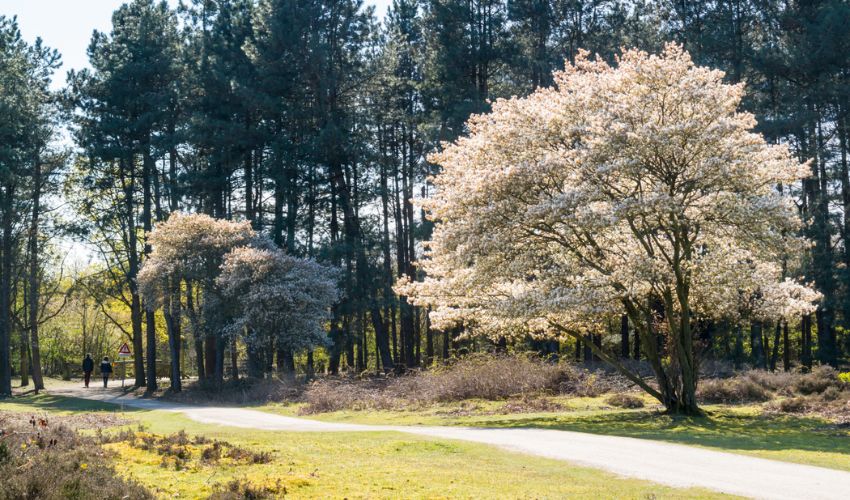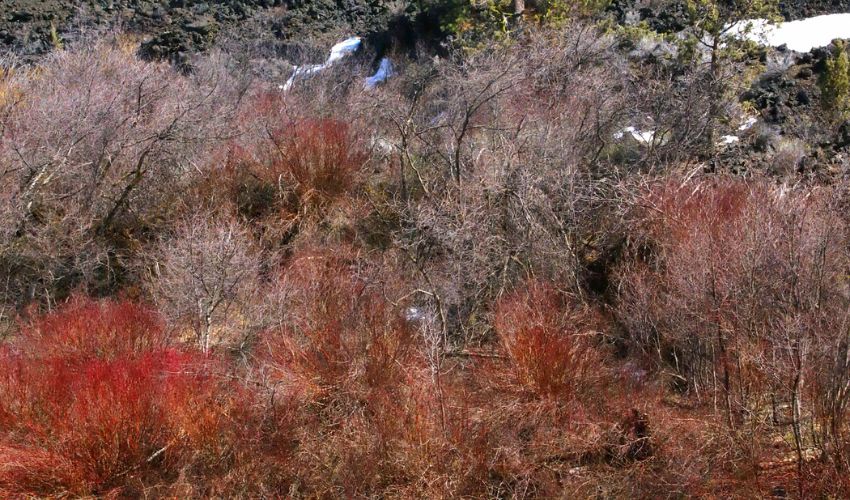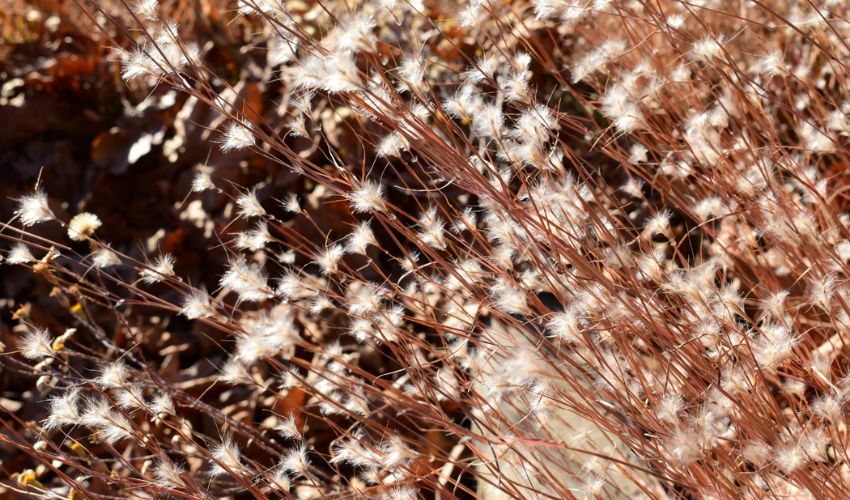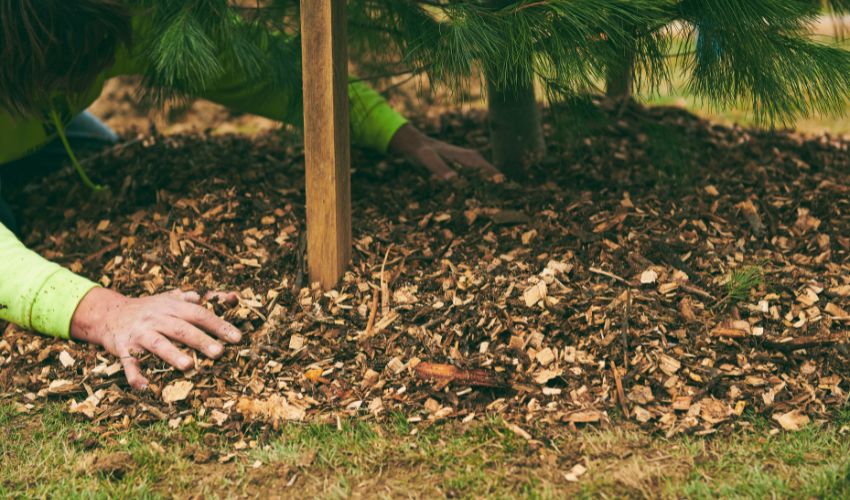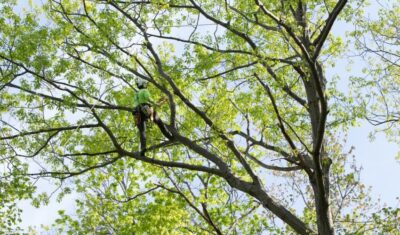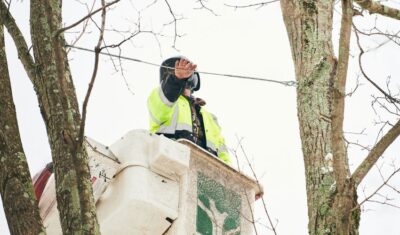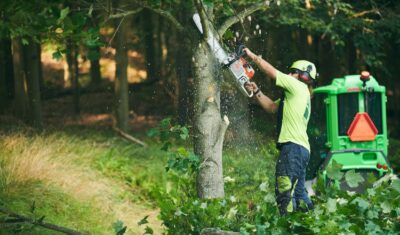Adding wildlife-friendly plants to your yard can bring natural beauty to your outdoor space while supporting important local ecosystems. By choosing mostly native trees, shrubs, and wildflowers, you can create a thriving habitat for birds, insects, and small mammals, adding life and interest to your property.
In Northeast Ohio, the right plant choices can make your yard welcoming for wildlife year-round. If you’re ready to turn your yard into a natural haven with wildlife-friendly landscaping, start with some of these trees and plants that our furry, feathered, and buzzing friends depend on for food, shelter, and habitat.
Key Takeaways:
- Planting a variety of native trees, shrubs, grasses, and flowers can attract diverse wildlife to your yard, creating a vibrant ecosystem right at home.
- Oak trees, eastern red cedar, and serviceberry are excellent choices for attracting birds and small mammals.
- Dense shrubs are a favorite for many bird species that use species like American hazelnut and spicebush for both food and cover.
- Wildflowers and grasses such as milkweed and little bluestem support many pollinators and small animals, while adding color and texture to your landscape.
- A wildlife-friendly yard is a combination of diverse native plantings, a water source, and reduced chemical use to allow the entire ecosystem to thrive.
Why You Should Welcome Wildlife to Your Yard
Planting trees and plants that attract wildlife goes beyond just enjoying nature. It can also make your yard healthier and more resilient. Here are some key benefits:
- Natural Pest Control: Birds and beneficial insects can help reduce harmful pests in your yard.
- Pollinator Support: Bees, butterflies, and other pollinators will thrive, leading to better flowering and fruit production in your garden and local community.
- Increased Biodiversity: A variety of native plants supports many wildlife species, increasing the diversity in your yard. Greater biodiversity also limits the damage that individual pests or diseases can cause to your landscape.
Of all the benefits of wildlife-friendly landscaping, perhaps the most rewarding is simply enjoying the wildlife itself. Imagine sitting on your patio, watching birds as you sip your morning coffee, or seeing butterflies flutter outside your kitchen window. It’s an invitation to fully appreciate your landscape and spend more time outdoors.
Best Native Trees for Attracting Wildlife in NE Ohio
When it comes to attracting wildlife to your Northeast Ohio backyard, native trees are your best bet. These trees have evolved alongside local wildlife, providing them with the food, shelter, and habitat they need to thrive. By planting native trees, you’re not only supporting local ecosystems but also creating a beautiful and biodiverse space that you can enjoy for years to come.
Oaks
Oak trees are key for wildlife. They’re one of the most important species for local ecosystems in the US. Their acorns provide food for squirrels, deer, turkeys, and other small mammals, while their large branches offer nesting spots and shelter for birds.
Oaks also support many insect species, feeding more than 900 different species of moth and butterfly caterpillars, which in turn attract more wildlife to your yard. While you might not like caterpillars due to the leaf damage they can cause, they’re the main food source for young birds.
Growing Requirements and Wildlife Attraction
- Sunlight: Most oaks in Ohio prefer full sun to partial shade
- Attracts: Birds, squirrels, insects, deer
Eastern Red Cedar
Eastern red cedar is valuable to wildlife year-round, with birds flocking to its blue berries in fall and winter. Its dense foliage provides shelter for birds and small mammals, making it a great addition to any wildlife-friendly yard.
These trees also add much needed greenery throughout winter and act as a windbreak. Plant it near a sitting area for both privacy and the pleasant woodsy scent of fresh cedar.
Growing Requirements and Wildlife Attraction
- Sunlight: Full sun
- Growing Conditions: Tolerates dry to moderately wet soil; thrives in nearly any soil, including poor, rocky, or sandy
- Attracts: Birds (especially in winter), pollinators, small mammals
Serviceberry
Serviceberry trees produce sweet, edible berries that attract birds, especially in early summer. Its burst of flowers early in spring provides an important food source for pollinators before many other plants start flowering.
These small, often multi-trunked trees provide year-round visual interest in residential and commercial landscapes. As an understory tree, they can also grow well in shade.
Growing Requirements and Wildlife Attraction
- Sunlight: Full sun to shade
- Growing Conditions: Prefers moist, well-drained soil; tolerates some drought once established
- Attracts: Birds, bees, butterflies
Black Walnut
Black walnut trees produce nuts that squirrels and other wildlife love. The large canopy provides excellent shelter, but be careful when planting as the tree produces a chemical called juglone, which can inhibit the growth of certain plant species.
It’s a versatile tree, able to grow in most soil conditions. It grows quickly, especially in its first few years. However, it grows slowly in dry or poor soil.
Black walnut is valuable for wildlife, but it can be messy. It drops leaves and twigs regularly. They’re best for larger yards and landscapes.
Growing Requirements and Wildlife Attraction
- Sunlight: Full sun
- Growing Conditions: Prefers deep, rich, well-drained soil; tolerates a variety of moisture conditions
- Attracts: Squirrels, birds, small mammals
Best Native Shrubs for Attracting Wildlife
American Hazelnut
American hazelnut is a great shrub for wildlife, producing nuts that feed various animals. These nuts are also prized by people. This shrub creates dense thickets that provide shelter for birds and small mammals.
Over time, they can reach 15 feet in height and width. They work well as a screening plant, especially considering their tendency to produce suckers.
Growing Requirements and Wildlife Attraction
- Sunlight: Full sun to partial shade
- Growing Conditions: Prefers moist, well-drained soil; tolerates different soil types including loam and clay
- Attracts: Birds, squirrels, small mammals, and people
Spicebush
Spicebush is a versatile shrub with fragrant blooms that attract early-season pollinators. It’s one of the first to bloom in Ohio, sometimes as early as late winter. Its bright red berries are a favorite of birds in the fall. It also acts as a host plant for the spicebush swallowtail butterfly.
Growing Requirements and Wildlife Attraction
- Sunlight: Partial to full shade
- Growing Conditions: Prefers moist, well-drained soils; tolerant of a range of soil types
- Attracts: Birds, butterflies, bees
Red Osier Dogwood
Known for its striking red stems in winter, red osier dogwood is also great for wildlife. It provides shelter for animals and its berries are an excellent food source for birds. Deer are known to browse on dogwoods year-round.
These shrubs have a messy, sprawling growth habit, but they tolerate and even prefer regular pruning to develop straight regrowth. They’re often planted in groups, along with evergreens for striking color in winter.
Growing Requirements and Wildlife Attraction
- Sunlight: Full sun to partial shade
- Growing Conditions: Prefers wet to moist soil; tolerates periodic flooding and thrives near water bodies
- Attracts: Birds, butterflies, small mammals, deer
Native Wildflowers and Grasses for Pollinators and Small Wildlife
Milkweed
Milkweed is famous for supporting monarch butterflies, providing a place for the butterflies to lay their eggs and for the larvae to feed. Its clusters of pink or white flowers also attract many other pollinators. Adding a few of these plants is a must for wildlife enthusiasts.
Growing Requirements and Wildlife Attraction
- Sunlight: Full sun
- Growing Conditions: Prefers well-drained soil; tolerates some drought
- Attracts: Monarch butterflies, bees, other pollinators
Goldenrod
Goldenrod provides nectar for many types of pollinators, especially late in the growing season when other plants have finished blooming. Its seeds also attract birds. And it’s the host plant for a handful of stunning moth species. Goldenrod is deer resistant.
Growing Requirements and Wildlife Attraction
- Sunlight: Full sun to partial shade
- Growing Conditions: Prefers well-drained soil; drought tolerant once established
- Attracts: Pollinators, birds
Little Bluestem
Little bluestem is a native grass that offers shelter for small mammals and provides food for birds. It’s also great for adding texture to your garden. It’s drought tolerant and thrives in poor soil, requiring very little maintenance.
While it’s most visible and vibrant in summer, this grass persists throughout winter. All you need to do is plant it in full sun and cut it to the ground in early spring.
Growing Requirements and Wildlife Attraction
- Sunlight: Full sun
- Growing Conditions: Prefers dry to medium, well-drained soil; tolerates poor soils
- Attracts: Birds, small mammals, insects
Best Trees and Plants to Attract Specific Wildlife
For Deer:
- Red maple
- White oak
- American beech
- American hazelnut
- Wild crabapple
For Birds:
- Eastern red cedar
- Serviceberry
- Red osier dogwood
- Black cherry
- American holly
For Small Mammals:
- Black walnut
- American hazelnut
- Oak trees
- Red osier dogwood
- American beech
For Butterflies:
- Milkweed
- Spicebush
- Purple coneflower
- Joe Pye weed
- Asters
Tips for Creating a Wildlife-Friendly Yard
To make your yard as inviting as possible for wildlife, use a variety of native plants and trees that provide food, shelter, and nesting opportunities. Here are a few additional tips to consider:
- Mix It Up: Use a combination of trees, shrubs, and wildflowers to create layers of habitat for different species. Animals use different types of plants for food, cover, and nesting.
- Add Water: Adding a birdbath, small pond, or water feature can attract a wide range of wildlife, including birds, butterflies, and insects.
- Minimize Chemicals: Limit the use of broad-spectrum pesticides and herbicides that can harm wildlife. Consider natural alternatives or at the very least, try to spot treat weeds and pests and apply herbicides carefully to avoid damage to your valued trees.
- Plant in Clusters: Grouping similar plants together can create mini-habitats that are more attractive to wildlife than isolated specimens surrounded by grass.
And be sure to plant your new trees and plants at the right time to maximize their chances of success!
Preparing Your Yard for New Plantings
Do you have underperforming, non-native trees that don’t attract the wildlife you want? Or invasive species like tree of heaven or Norway maple that overtake beneficial habitat? The first step in creating a wildlife-friendly yard is removing any unwanted trees to clear space for new growth.
If you’re unsure about which trees to remove, or if you need help with the removal process, contact Independent Tree today. We can help you prepare your yard for a new season of growth.
Not only that, but we can even plant new trees and shrubs for you, ensuring your new plantings have the best chances of success.
Create a Thriving Habitat in Your Northeast Ohio Yard
By planting native trees, shrubs, and wildflowers, you can create a yard that invites local wildlife and supports Northeast Ohio’s ecosystems. With a mix of food sources, shelter, and habitats, your yard can become a haven for birds, bees, butterflies, and other animals.
If you need to remove any unwanted trees or shrubs to prepare your new, wildlife friendly habitat, or if you want experts to plant your new trees and shrubs with precision, call us today at 440-564-1374 and we’ll be happy to provide guidance and a free estimate.
Transform Your Yard into a Wildlife Haven Today!
Ready to attract more birds and butterflies to your backyard? Our expert team at Independent Tree is here to help you create a thriving, wildlife-friendly landscape with native trees and plants that support your local ecosystem. Contact us now for a free consultation and learn how you can transform your outdoor space into a natural sanctuary!Recent Articles
Topics
About The Author

STAY IN THE LOOP
WITH OUR
LATEST UPDATES
"*" indicates required fields

